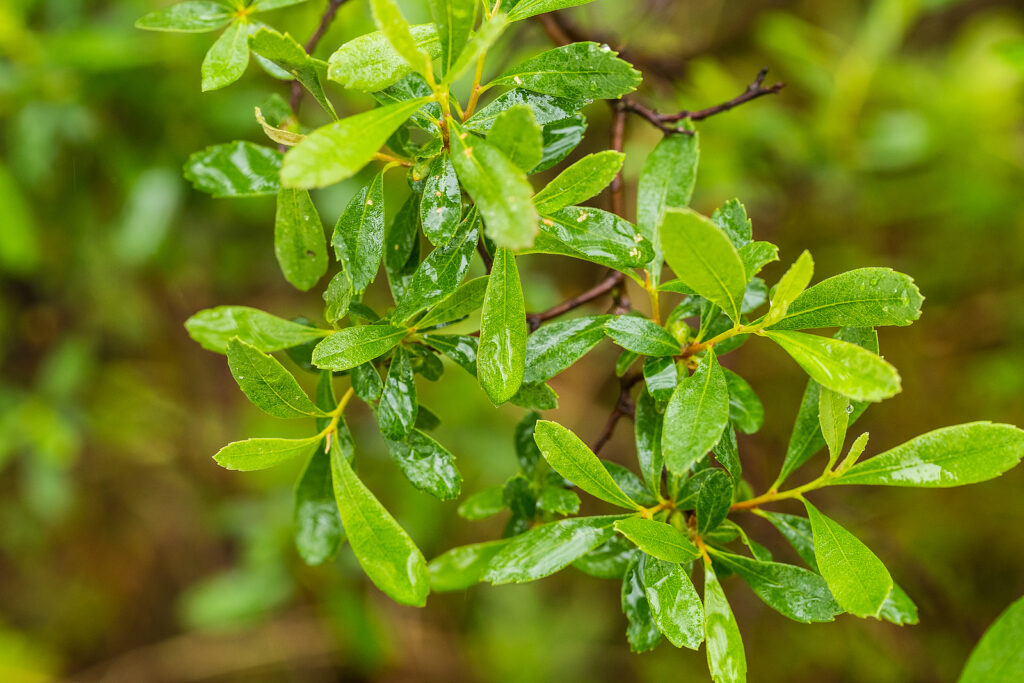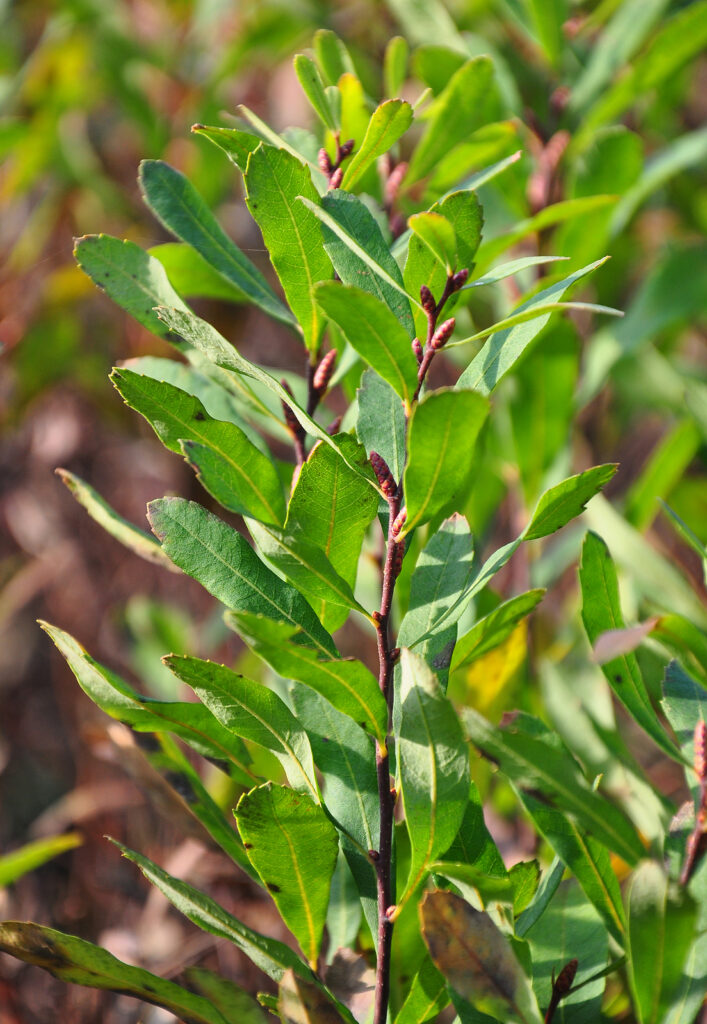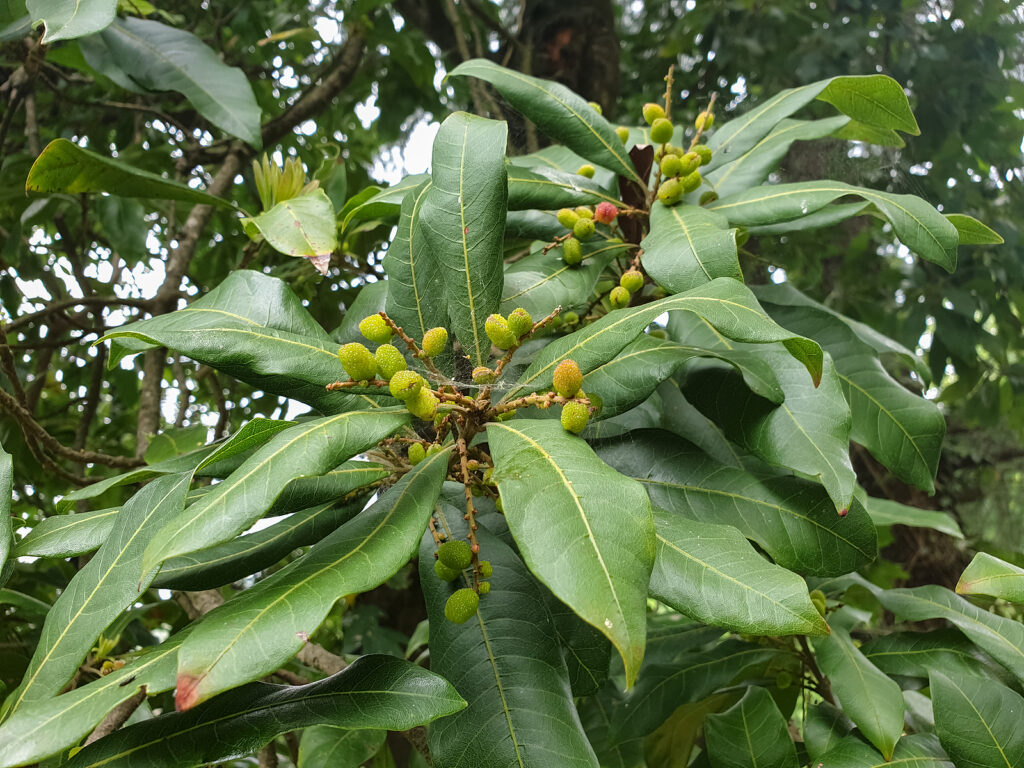Myrica — commonly called wax myrtle or northern bayberry–is an aromatic shrub and attractive small berries that appeal to birds. Myrica does not have showy flowers.
Myrica is commonly used as an informal hedge, screening plant, and along roadsides. It is handsome but tough plant; Myrica can withstand salt spray, drought, or boggy sites.
Myrica is found in many regions around the world. To ensure cold hardiness where you live look for plants that are locally grown or grown in colder regions than yours. Genetic variations allow Myrica to adapt to varied climates.
The Myrica genus includes about 50 species, some deciduous, some evergreen. Myrica suckers so its important to locate it where you can keep it under control. Some species will grow to tree size.

Get to know Myrica
- Plant type: Deciduous or semi-evergreen shrub.
- Growing zones and range: Zones 4 to 8.
- Hardiness: Hardy to Zone 4
- Height and width: 9 feet (2.7m) tall; Myrica grows 5 to 12 feet (1.5-4m) wide depending on the variety.
- Foliage: Glossy, green, aromatic leaves and gray berries; leaves remain on the plants until late fall; oliage is pleasantly aromatic.
- Flowers: Male plants produce yellowish-green catkins; female plants produce waxy berries, which are used for making candles.
- Bloom time: Spring.
- Uses: Shrub border or seashore garden; some species are good for screen plants, informal hedges, roadside or background plantings.
- Garden companions: Rugosa rose (Rosa rugosa)
- Common name: Northern bayberry, wax myrtle
- Botanical name: Myrica
- Family name: Myricaceae
- Origin: North America, Europe
Where to plant Myrica
- Plant Myrica in full sun or light shade.
- Plant Myrica in well-drained, moist, humus-rich soil. Myrica also does well in poor, sandy soil.
- Myrica can withstand challenging situations such as salt spray, drought, or boggy sites.

When to plant Myrica
- Set container-grown Myrica in the garden in spring or autumn.
- Sow Myrica seed in containers outdoors when ripe.
- Root greenwood cuttings in early or midsummer.
- Layer Myrica in spring.
Planting and spacing Myrica
- Space Myrica 5 to 12 feet (1.5-4m) apart.
- Sow seed 1/8 inch deep in evenly prepared soil.
How to water and feed Myrica
- Water needs for Myrica vary by species; it is best to keep the soil evenly moist but not wet.
- Fertilize Myrica with an all-purpose organic fertilizer in spring.

How to care for Myrica
- You must have both male and female Myrica to get berries.
- Myrica requires little pruning, but responds swell to cutting back if you want to control size or shape.
Myrica pests and diseases
- Myrica can develop rot, leaf spot, rust, or dieback.
- Myrica has few pest problems.
Myrica propagation
- Take Myrica softwood cuttings in early summer.
- Propagate Myrica from seeds by first removing their waxy coating; two months’ cold stratification may help.
- Sow Myrica seed in containers outdoors when ripe.
- Layer Myrica in spring.
Myrica varieties to grow
- Myrica californica, Pacific wax myrtle: evergreen shrub, native to southeastern U.S.; grows 10 15-20 feet (4.5-6.1m), possibly taller; it is often multitrunked, and its branches are dense with glossy, toothed, dark green leaves to 3.5 inches (8.8cm) long; grayish-white fruits are heavily coated with a wax valued in candlemaking; fruits are persistent if not removed by birds; a good specimen tree, hedge; requires regular water. Zones 6 to 10.
- M. cerifera, Southern wax myrtle: Southeast native evergreen, also called candleberry, can grow more than 30 feet (9.1m) tall in the wild but usually remains 10-15 feet (3-4.5m) tall in a garden; fragrant, usually narrow, olive greening; requires little pruning, but responds well to cutting back if you want to control size or shape; propagate from seeds by first removing their waxy coating; two months’ cold stratification may help. Propagate M. cerifera from semi-hardwood cuttings in early summer or root cuttings in winter. Grows well in Florida, but may die in a cold Georgia winter. Its coastal origins make it tolerant of less than ideal soil conditions, although it’s best to provide humusy, well-draining soil in full sun or partial shade. Zones 7 to 10.
- M. gale, sweet fern, sweet gale,: deciduous shrub, native to much of the Northern Hemisphere; dense, erect growth to as tall as 6 feet (1.8m), more typically 2-4 feet (.6-1.2m); male plants have yellow-brown catkins in mid-to-late spring, followed by round yellow-brown fruits on the female plants; often grown for its fragrant leaves that are dark bluish-green and grow to 2.5 inches (6.2cm) long; takes regular moisture or boggy conditions. Zones 1 to 6.
- M. pennsylvanica (M.caroliniensis), bayberry: deciduous to semi-evergreen shrub, native to eastern U.S. Dense, compact growth to 9 feet (2.7m); it suckers to form grounded colonies. Fragrant leaves to about 4 inches (10cm) long, narrowish, glossy green, dotted with resin glands; roundish fruit is covered with white wax—the bayberry wax used for candles.; tolerates seashore conditions—poor sandy or salty soil, wind; fair tolerance for roadside salt; needs regular water. M. heterophylla is similar to M. pensylvanica, but has somewhat larger leaves. Both species are semi-evergreen in the southern part of the U.S., deciduous farther north. Zones 3 to 6.















